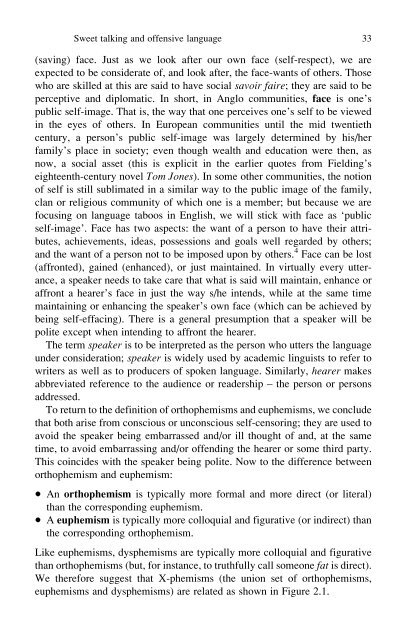Forbidden Words: Taboo and the Censoring of Language
Forbidden Words: Taboo and the Censoring of Language
Forbidden Words: Taboo and the Censoring of Language
Create successful ePaper yourself
Turn your PDF publications into a flip-book with our unique Google optimized e-Paper software.
Sweet talking <strong>and</strong> <strong>of</strong>fensive language 33<br />
(saving) face. Just as we look after our own face (self-respect), we are<br />
expected to be considerate <strong>of</strong>, <strong>and</strong> look after, <strong>the</strong> face-wants <strong>of</strong> o<strong>the</strong>rs. Those<br />
who are skilled at this are said to have social savoir faire; <strong>the</strong>y are said to be<br />
perceptive <strong>and</strong> diplomatic. In short, in Anglo communities, face is one’s<br />
public self-image. That is, <strong>the</strong> way that one perceives one’s self to be viewed<br />
in <strong>the</strong> eyes <strong>of</strong> o<strong>the</strong>rs. In European communities until <strong>the</strong> mid twentieth<br />
century, a person’s public self-image was largely determined by his/her<br />
family’s place in society; even though wealth <strong>and</strong> education were <strong>the</strong>n, as<br />
now, a social asset (this is explicit in <strong>the</strong> earlier quotes from Fielding’s<br />
eighteenth-century novel Tom Jones). In some o<strong>the</strong>r communities, <strong>the</strong> notion<br />
<strong>of</strong> self is still sublimated in a similar way to <strong>the</strong> public image <strong>of</strong> <strong>the</strong> family,<br />
clan or religious community <strong>of</strong> which one is a member; but because we are<br />
focusing on language taboos in English, we will stick with face as ‘public<br />
self-image’. Face has two aspects: <strong>the</strong> want <strong>of</strong> a person to have <strong>the</strong>ir attributes,<br />
achievements, ideas, possessions <strong>and</strong> goals well regarded by o<strong>the</strong>rs;<br />
<strong>and</strong> <strong>the</strong> want <strong>of</strong> a person not to be imposed upon by o<strong>the</strong>rs. 4 Face can be lost<br />
(affronted), gained (enhanced), or just maintained. In virtually every utterance,<br />
a speaker needs to take care that what is said will maintain, enhance or<br />
affront a hearer’s face in just <strong>the</strong> way s/he intends, while at <strong>the</strong> same time<br />
maintaining or enhancing <strong>the</strong> speaker’s own face (which can be achieved by<br />
being self-effacing). There is a general presumption that a speaker will be<br />
polite except when intending to affront <strong>the</strong> hearer.<br />
The term speaker is to be interpreted as <strong>the</strong> person who utters <strong>the</strong> language<br />
under consideration; speaker is widely used by academic linguists to refer to<br />
writers as well as to producers <strong>of</strong> spoken language. Similarly, hearer makes<br />
abbreviated reference to <strong>the</strong> audience or readership – <strong>the</strong> person or persons<br />
addressed.<br />
To return to <strong>the</strong> definition <strong>of</strong> orthophemisms <strong>and</strong> euphemisms, we conclude<br />
that both arise from conscious or unconscious self-censoring; <strong>the</strong>y are used to<br />
avoid <strong>the</strong> speaker being embarrassed <strong>and</strong>/or ill thought <strong>of</strong> <strong>and</strong>, at <strong>the</strong> same<br />
time, to avoid embarrassing <strong>and</strong>/or <strong>of</strong>fending <strong>the</strong> hearer or some third party.<br />
This coincides with <strong>the</strong> speaker being polite. Now to <strong>the</strong> difference between<br />
orthophemism <strong>and</strong> euphemism:<br />
An orthophemism is typically more formal <strong>and</strong> more direct (or literal)<br />
than <strong>the</strong> corresponding euphemism.<br />
A euphemism is typically more colloquial <strong>and</strong> figurative (or indirect) than<br />
<strong>the</strong> corresponding orthophemism.<br />
Like euphemisms, dysphemisms are typically more colloquial <strong>and</strong> figurative<br />
than orthophemisms (but, for instance, to truthfully call someone fat is direct).<br />
We <strong>the</strong>refore suggest that X-phemisms (<strong>the</strong> union set <strong>of</strong> orthophemisms,<br />
euphemisms <strong>and</strong> dysphemisms) are related as shown in Figure 2.1.

















